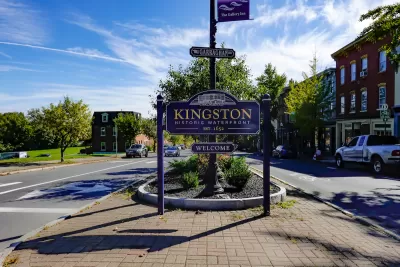Kingston recently adopted a form-based code, taking the rare step to entirely replace its old zoning code with form-based standards while also repealing parking requirements and allowing accessory dwelling units and missing middle housing.

The city of Kingston, New York, located north of New York City along the Hudson River, adopted a new form-based code earlier this month. According to local news reports, the form-based code is intended to mitigate the growing cost of housing in the city by allowing accessory dwelling units and new opportunities for infill development.
According to an article by Phillip Pantuso, Kingston’s new code is notable for replacing its entire zoning code with a new form-based code—most cities who have applied form-based codes do so only in certain nieghborhoods or along specific streets.
“The new zoning code was developed over a three-year period with the consulting firm Dover, Kohl & Partners and included regular community input organized in part by the local advocacy group Kingston Code Reform Advocates,” reports Pantuso.
Among the changes accomplished by Kingston’s new form-based zoning code are the end of minimum parking requirements, the legalization of missing middle housing, corner stores, and accessory dwelling units, and a new, “streamlined” development approval process.
Here is how Pantuso describes form-based codes:
Form-based codes address the relationship between building facades and public space, the form and mass of buildings in relation to one another, and the scale and types of streets and blocks, according to the Form-Based Codes Institute, a nonprofit focused on creating healthy communities. The goal is to emphasize creating cohesive and visually appealing communities that promote walkability and mixed-use development.
FULL STORY: Kingston passes form-based zoning code to aid affordable housing

Alabama: Trump Terminates Settlements for Black Communities Harmed By Raw Sewage
Trump deemed the landmark civil rights agreement “illegal DEI and environmental justice policy.”

Planetizen Federal Action Tracker
A weekly monitor of how Trump’s orders and actions are impacting planners and planning in America.

Why Should We Subsidize Public Transportation?
Many public transit agencies face financial stress due to rising costs, declining fare revenue, and declining subsidies. Transit advocates must provide a strong business case for increasing public transit funding.

Understanding Road Diets
An explainer from Momentum highlights the advantages of reducing vehicle lanes in favor of more bike, transit, and pedestrian infrastructure.

New California Law Regulates Warehouse Pollution
A new law tightens building and emissions regulations for large distribution warehouses to mitigate air pollution and traffic in surrounding communities.

Phoenix Announces Opening Date for Light Rail Extension
The South Central extension will connect South Phoenix to downtown and other major hubs starting on June 7.
Urban Design for Planners 1: Software Tools
This six-course series explores essential urban design concepts using open source software and equips planners with the tools they need to participate fully in the urban design process.
Planning for Universal Design
Learn the tools for implementing Universal Design in planning regulations.
Caltrans
Smith Gee Studio
Institute for Housing and Urban Development Studies (IHS)
City of Grandview
Harvard GSD Executive Education
Toledo-Lucas County Plan Commissions
Salt Lake City
NYU Wagner Graduate School of Public Service





























